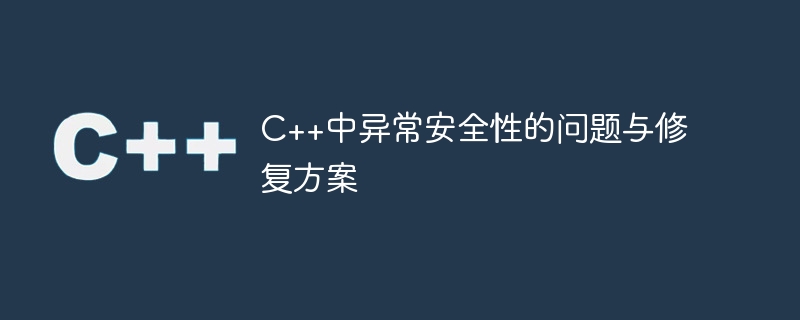Home >Backend Development >C++ >Exception safety problems and fixes in C++
Exception safety problems and fixes in C++
- WBOYWBOYWBOYWBOYWBOYWBOYWBOYWBOYWBOYWBOYWBOYWBOYWBOriginal
- 2023-10-08 15:09:21972browse

Exception safety problems and repair solutions in C
Introduction:
Exception safety means that the program can ensure the correct release and release of resources when an exception occurs. State recovery to avoid resource leaks and data inconsistencies. In C programming, exception safety is an important design principle that can improve the reliability and robustness of your program. However, there are some common exception safety problems in C. This article will introduce these problems, provide corresponding fixes, and give code examples to illustrate.
1. Problems with exception security
- Resource leakage: When an exception occurs, dynamically allocated resources fail to be released correctly, resulting in resource leakage. For example, memory is allocated through the new keyword but the delete operation is ignored, or a file is opened but the closing operation is ignored.
- Data inconsistency: When an exception occurs, the data state of the object cannot be restored correctly, resulting in data inconsistency. For example, some properties of an object are modified in a function but are not restored correctly when an exception occurs, leaving the object in an inconsistent state.
- Circular references: Circular references between objects may cause resources to not be released correctly. When two or more objects refer to each other and have pointers or references to each other, resource leaks will occur if the destruction or release of the objects is not handled correctly.
2. Repair plan
- Use smart pointers: C 11 introduced smart pointers (such as std::unique_ptr and std::shared_ptr), which can automatically manage dynamic allocation release of resources. Using smart pointers can avoid the problem of forgetting to release resources and can automatically release resources when an exception occurs.
- Exception-safe constructors and destructors: In the constructor and destructor of an object, appropriate exception handling mechanisms should be used to ensure that the object can correctly release resources and restore state when an exception occurs. You can use try-catch statements to catch exceptions, and release resources and reset status in the destructor.
- Exception-safe operator overloading: For classes that need to use operator overloading, it is necessary to ensure that resource leaks or data inconsistencies will not occur during the operator overloading process. Exception safety can be achieved by using RAII (Resource Acquisition Is Initialization) technology to manage resources using smart pointers in operator overloaded functions.
- Use exception-safe containers: When using containers in C STL, you need to pay attention to exception safety. Many STL containers provide exception-safe operations, such as ensuring that if an exception occurs when inserting elements, the state of the container will not change.
3. Code Example
The following is a sample code that uses smart pointers to achieve exception safety:
#include <iostream>
#include <memory>
class Resource {
public:
Resource() {
std::cout << "Resource acquired." << std::endl;
}
~Resource() {
std::cout << "Resource released." << std::endl;
}
void operation() {
std::cout << "Resource being used." << std::endl;
throw std::runtime_error("Exception occurred during operation.");
}
};
void func() {
std::unique_ptr<Resource> ptr(new Resource());
ptr->operation();
// Exception occurred, but resource will still be released
}
int main() {
try {
func();
} catch (const std::exception& e) {
std::cout << "Exception caught: " << e.what() << std::endl;
}
return 0;
}The above code uses the std::unique_ptr smart pointer to manage the Resource class dynamic allocation of resources. Even if an exception occurs in the operation function of the Resource class, since std::unique_ptr will automatically call the destructor at the end of the scope, the resource will still be released correctly. In the main function, handle the exception accordingly by catching it.
Conclusion:
In C programming, exception safety is an important design principle to improve program reliability and robustness. In order to avoid exception safety issues such as resource leaks and data inconsistencies, we can use repair solutions such as smart pointers, exception-safe constructors and destructors, and exception-safe operator overloading. By focusing on exception safety during the design and implementation process, we can ensure that the program can still correctly release resources and restore state when an exception occurs, improving the reliability of the code.
The above is the detailed content of Exception safety problems and fixes in C++. For more information, please follow other related articles on the PHP Chinese website!

